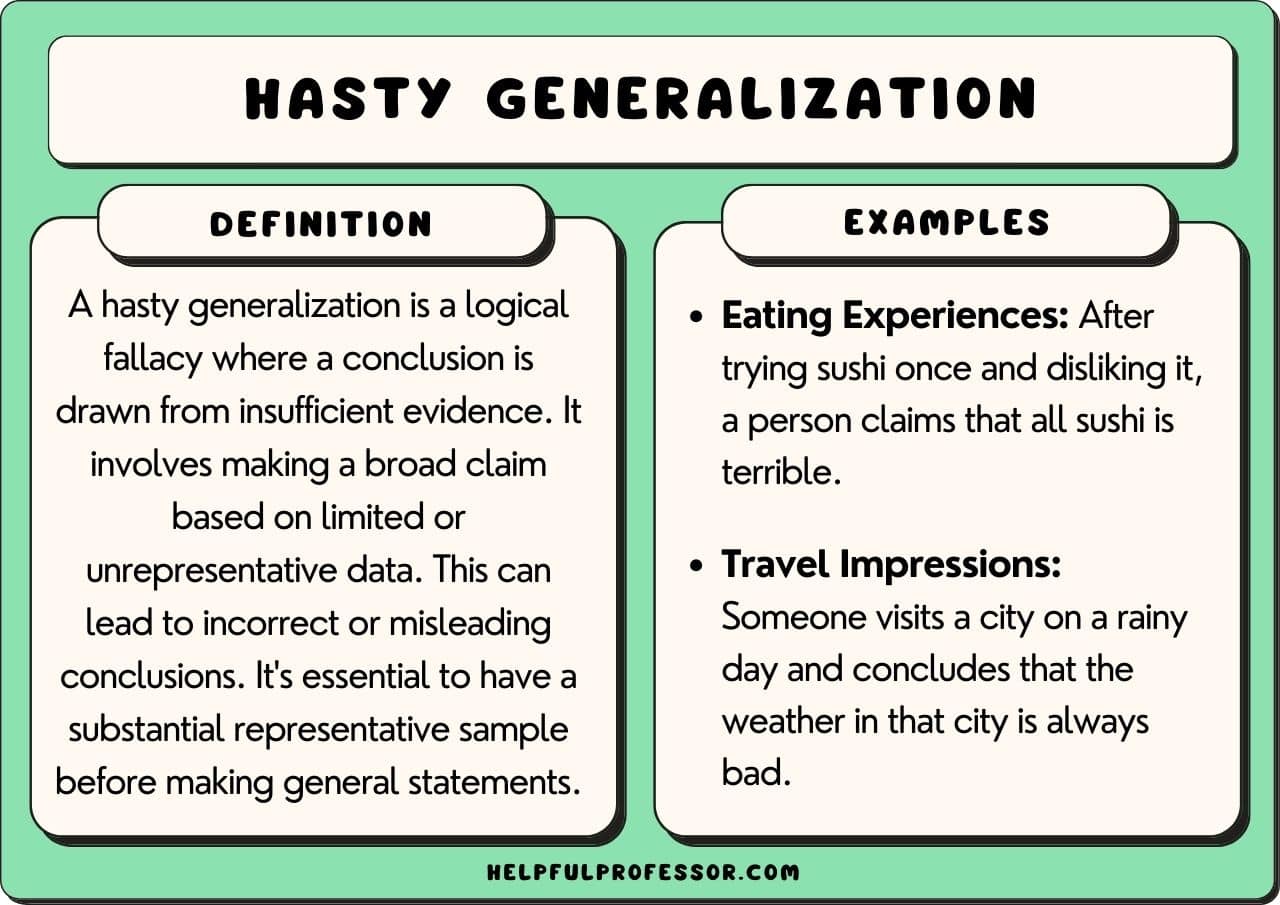Which Of These Is An E Ample Of A Hasty Generalization
Which Of These Is An E Ample Of A Hasty Generalization - Or just a small piece? Web updated june 17, 2022. X is true for a. Web there are, then, different ways of checking whether a scientific generalization is hasty. This fallacy occurs when an argument is based on a body of evidence that is simply too small. You're about to learn the ins and outs of the hasty generalization fallacy. Also known as hasty induction or overextension, a hasty generalization is a form of jumping to a conclusion. Of these, the authors found that 166 of the putative associations had been reported three or more times. X is true for b. For instance, saying “all swans must be white” after seeing only white swans is a hasty generalization.
Web there are, then, different ways of checking whether a scientific generalization is hasty. Instead of looking into examples and evidence that are much more in line with the typical or average situation, you draw a conclusion about a large population using a small, unrepresentative sample. Also known as hasty induction or overextension, a hasty generalization is a form of jumping to a conclusion. Instead of looking at a representative sample or gathering enough data, they make a sweeping generalization that may not be accurate or justified. This fallacy occurs when an argument is based on a body of evidence that is simply too small. A hasty generalization occurs when someone generalizes an experience from examples, not evidence. A hasty generalization refers to two distinct fallacies identified by aristotle[1].
Web the hasty generalization fallacy is the error of forming a broad conclusion based on an inadequate dataset. Instead of looking into examples and evidence that are much more in line with the typical or average situation, you draw a conclusion about a large population using a small, unrepresentative sample. Web hasty generalization / whataboutism: Web hasty generalization, in a nutshell, is a logical fallacy where someone draws a broad conclusion based on insufficient or limited evidence. A hasty generalization refers to two distinct fallacies identified by aristotle[1].
Web hasty generalization fallacy examples: Examples of avoiding hasty generalizations. Web hasty generalization, in a nutshell, is a logical fallacy where someone draws a broad conclusion based on insufficient or limited evidence. It primarily includes a small group and aims to infer a generalization about that random sample to a general community, but it fails miserably. For instance, saying “all swans must be white” after seeing only white swans is a hasty generalization. This is also known by several other names:
Therefore, x is true for c, d, e, etc. The key here is a. Web updated june 17, 2022. The fallacy involves making broad generalizations based on this inadequate sample. Perhaps the main technique, taking a list of specific bad actions by israel and using that small set of bad actions to generalize that israel is.
Web hasty generalization / whataboutism: This fallacy occurs when an argument is based on a body of evidence that is simply too small. Web hasty generalization usually follows the pattern: Instead of looking at a representative sample or gathering enough data, they make a sweeping generalization that may not be accurate or justified.
Of This Group Only Six Were Consistently Replicated (Hirschhorn Et Al., Citation 2002).
A hasty generalization is a logical fallacy in which a person makes a conclusion based on insufficient or nonrepresentative evidence. Web now, we're unpacking the hasty generalizations fallacy. You're about to learn the ins and outs of the hasty generalization fallacy. Web a recent analysis of these studies identified 600 articles that reported positive associations between common gene variants and diseases.
A Hasty Generalization Fallacy, Also Called Secundum Quid Jumping To Conclusions Or Anecdotal Evidense, Is A Logical Error When You Reach A Conclusion Not Supported Logically Or By Sufficient Evidence.
Web in other words, the fallacy of composition is using an unwarranted assumption that we can infer something about a whole based on the characteristics of its parts, while the hasty generalization fallacy is using insufficient evidence to draw a conclusion. Perhaps the main technique, taking a list of specific bad actions by israel and using that small set of bad actions to generalize that israel is. Also known as hasty induction or overextension, a hasty generalization is a form of jumping to a conclusion. They get an idea in their head that is, generally, based on a hasty generalization.
The First Fallacy Involves Inappropriately Generalizing From A Specific Instance To A Universal Generalization Without Considering All Relevant Factors.
It’s like deciding something about a whole group based on just one example. Web hasty generalization fallacy examples: Web hasty generalization is a logical fallacy where conclusions are drawn based on insufficient or biased data. A hasty generalization refers to two distinct fallacies identified by aristotle[1].
Web A Hasty Generalization Is One Example Of A Logical Fallacy, Wherein Someone Reaches A Conclusion That Is Not Justified Logically By Objective Or Sufficient Evidence.
The fallacy involves making broad generalizations based on this inadequate sample. Web there are, then, different ways of checking whether a scientific generalization is hasty. Web a hasty generalization fallacy is a claim made on the basis of insufficient evidence. Whether a sample size is large enough to.

:max_bytes(150000):strip_icc()/hasty-generalization-fallacy-1690919-v7-CS-5b7c5d95c9e77c00253bfa9e.png)




